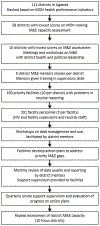Improving the ability of districts in Uganda to monitor their HIV programs
- PMID: 30918924
- PMCID: PMC6433397
Improving the ability of districts in Uganda to monitor their HIV programs
Abstract
Background: Although district health teams (DHT) in Uganda are supposed to monitor and support facilities to ensure quality HIV data collection, reporting and use, they are often ill-equipped to do so. We implemented a program designed to build the capacity of districts to manage and use their own HIV-related program data and to assist facilities to collect and evaluate their own data.
Methods: We conducted a baseline assessment of the monitoring and evaluation (M&E) capacity of 38 districts. In the 10 worst-performing districts, we identified and trained district-level staff to become M&E mentors who in turn trained and supervised facility-level staff. We collected information on action plans developed by facilities to address major issues of concern. Following the intervention, we reassessed M&E capacity of the 10 targeted districts.
Results: Among the 38 districts assessed, one-half did not have a biostatistician, less than one-quarter had staff trained in the basics of M&E or data analysis, and less than one-quarter had an M&E plan. The main concerns of facilities included lack of updated data collection tools, lack of supervision, inaccurate data recording, and limited ability to analyze and use data. In the 10 targeted districts, comparison before and after the intervention showed that the number of districts with trained M&E staff increased (4 to 9), the number of M&E plans increased (3 to 6), and the number using data for programming increased (4 to 8). Implementation of action plans by facilities successfully addressed many issues and led to improved programming.
Conclusion: Challenges of district M&E in Uganda mainly result from a lack of skilled human resources. On-the-job training and direct involvement of district staff to provide support to facilities can lead to improvements in data quality and use.
Keywords: HIV/AIDS; Uganda; capacity-building; evaluation; monitoring.
Conflict of interest statement
CONFLICT OF INTEREST The authors declare no financial, institutional or other conflicts of interest.
Figures
References
-
- Amoroso CL, Akimana B, Wise B, & Fraser HS (2010). Using electronic medical records for HIV care in rural Rwanda. Stud Health Technol Inform, 160(Pt 1), 337–341. - PubMed
-
- Belrhiti Z, Booth A, Marchal B, & Verstraeten R (2016). To what extent do site-based training, mentoring, and operational research improve district health system management and leadership in low- and middle-income countries: a systematic review protocol. Syst Rev, 5, 70. doi:10.1186/s13643-016-0239-z. - DOI - PMC - PubMed
-
- Edwards LJ, Moises A, Nzaramba M, Cassimo A, Silva L, Mauricio J, Wester CW, Vermund SH, Moon TD (2015). Implementation of a health management mentoring program: year-1 evaluation of its impact on health system strengthening in Zambezia Province, Mozambique. Int J Health Policy Manag, 4(6), 353–361. doi:10.15171/ijhpm.2015.58 - DOI - PMC - PubMed
Grants and funding
LinkOut - more resources
Full Text Sources

